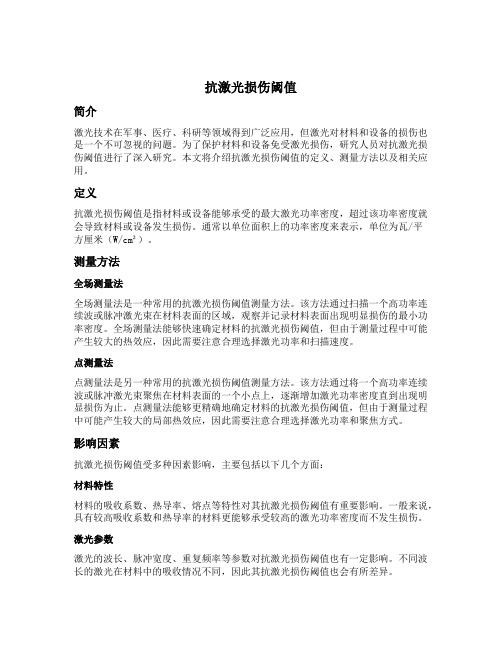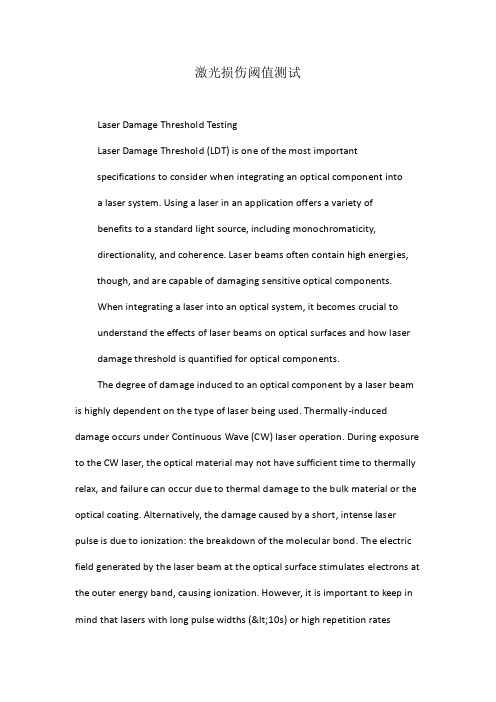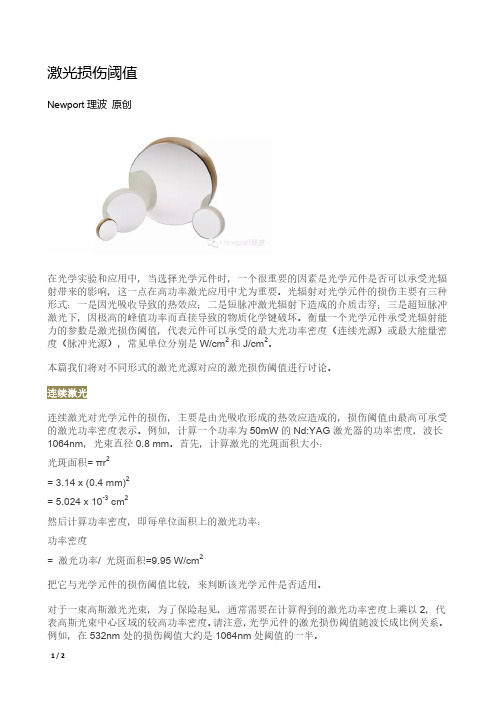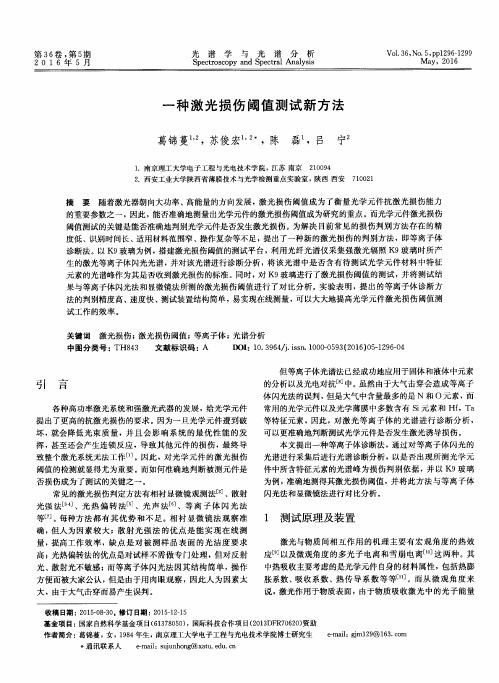激光损伤阈值测试
抗激光损伤阈值

抗激光损伤阈值简介激光技术在军事、医疗、科研等领域得到广泛应用,但激光对材料和设备的损伤也是一个不可忽视的问题。
为了保护材料和设备免受激光损伤,研究人员对抗激光损伤阈值进行了深入研究。
本文将介绍抗激光损伤阈值的定义、测量方法以及相关应用。
定义抗激光损伤阈值是指材料或设备能够承受的最大激光功率密度,超过该功率密度就会导致材料或设备发生损伤。
通常以单位面积上的功率密度来表示,单位为瓦/平方厘米(W/cm²)。
测量方法全场测量法全场测量法是一种常用的抗激光损伤阈值测量方法。
该方法通过扫描一个高功率连续波或脉冲激光束在材料表面的区域,观察并记录材料表面出现明显损伤的最小功率密度。
全场测量法能够快速确定材料的抗激光损伤阈值,但由于测量过程中可能产生较大的热效应,因此需要注意合理选择激光功率和扫描速度。
点测量法点测量法是另一种常用的抗激光损伤阈值测量方法。
该方法通过将一个高功率连续波或脉冲激光束聚焦在材料表面的一个小点上,逐渐增加激光功率密度直到出现明显损伤为止。
点测量法能够更精确地确定材料的抗激光损伤阈值,但由于测量过程中可能产生较大的局部热效应,因此需要注意合理选择激光功率和聚焦方式。
影响因素抗激光损伤阈值受多种因素影响,主要包括以下几个方面:材料特性材料的吸收系数、热导率、熔点等特性对其抗激光损伤阈值有重要影响。
一般来说,具有较高吸收系数和热导率的材料更能够承受较高的激光功率密度而不发生损伤。
激光参数激光的波长、脉冲宽度、重复频率等参数对抗激光损伤阈值也有一定影响。
不同波长的激光在材料中的吸收情况不同,因此其抗激光损伤阈值也会有所差异。
环境条件环境温度、湿度等条件对材料的抗激光损伤阈值也会产生影响。
高温和高湿度环境下,材料往往更容易受到激光损伤。
应用军事领域在军事领域,抗激光损伤阈值是评估装甲材料、飞行器外壳等设备在战场上是否能够抵御敌方激光武器攻击的重要指标。
通过研究和提高装甲材料的抗激光损伤阈值,可以提高战机、坦克等军事装备的生存能力和作战效能。
激光损伤阈值测试

激光损伤阈值测试Laser Damage Threshold TestingLaser Damage Threshold (LDT) is one of the most importantspecifications to consider when integrating an optical component intoa laser system. Using a laser in an application offers a variety ofbenefits to a standard light source, including monochromaticity,directionality, and coherence. Laser beams often contain high energies, though, and are capable of damaging sensitive optical components.When integrating a laser into an optical system, it becomes crucial tounderstand the effects of laser beams on optical surfaces and how laser damage threshold is quantified for optical components.The degree of damage induced to an optical component by a laser beam is highly dependent on the type of laser being used. Thermally-induced damage occurs under Continuous Wave (CW) laser operation. During exposure to the CW laser, the optical material may not have sufficient time to thermally relax, and failure can occur due to thermal damage to the bulk material or the optical coating. Alternatively, the damage caused by a short, intense laser pulse is due to ionization: the breakdown of the molecular bond. The electric field generated by the laser beam at the optical surface stimulates electrons at the outer energy band, causing ionization. However, it is important to keep in mind that lasers with long pulse widths (<10s) or high repetition rates(>10MHz) may also cause thermally induced damage. For these reasons, understanding laser damage threshold is crucial to designing and maintaining an optical system. -6T esting Laser Damage ThresholdLaser-induced damage threshold testing is a good method for quantifying the amount of electromagnetic radiation an optical component can withstand. There are a variety of different LDT tests. For example, Edmund Optics follows the ISO-11254 procedures and methods, which is the industry standard for determining the laser damage threshold of an optical component. Utilizing the ISO-11254 standard enables the fair comparison between optical components from different manufacturers.Edmund Optics' LDT testing is conducted by irradiating a number of test sites with a laser beam atdifferent energy densities for pulsed lasers, or different power densities for CW lasers. The energy density or power density is incrementally increased at a minimum of ten sites at each increment. The process is repeated until damage is observed in 100% of the irradiated sites. The LDT is the highest energy or power level at which no damage is observed in any of the irradiated sites. Inspection of the sites is done with a Nomarski-type Differential Interference Contrast (DIC) microscope with 100X - 150X magnification. Visible damage is observed and the results are recorded using pass/fail criteria. Figure 1 is a typical damage probability plot of exposure sites as a function of laserpulse energy.In addition to uncoated optical components, optical coatings are also subject to damage from the presence of absorption sites and plasma burn. Figure 2 is a real-world image of coating failure due to a coating defect. For additional information on the importance of LDT testing on coatings, view The Complexities of High-Power Optical Coatings.Figure 1:Exposure Histogram of Laser Damage Threshold Probability versus Exposure SiteFigure 2: Coating Failure from 73.3 J/cm3 Source due to Coating DefectDefining Laser Damage ThresholdThere are many variables that affect the Laser Damage Threshold (LDT) of an optical component. These variables can be separated into three categories: laser, substrate, and optical coating (Table 1).LDT is typically quantified with units of power or energy densities for CW and pulsed lasers, respectively. Power density is the power per cross-sectional beam area. Similarly, energy density is the energy per cross-sectional beam area of a specific pulse duration. Lasers are available with a multitude of different wavelengths and pulse durations, therefore, it is important that the optical component's LDT is suitable for the laser's parameters. As a general rule of thumb, Newton's square root scaling factor can be used to determine whether a laser can be used with an optic that is not rated at thesame LDT pulse duration specification. Equation 1 calculates a new LDT for the different pulse duration.(1)The LDT(y) is the estimated LDT for laser Y, and LDT(x) is the specified LDT for laser x. τ is the pulse duration for laser y, and τ is the pulse durat ion for laser x. Additionally, since the energy of a photon is inversely proportional to its wavelength, then theoretically the LDT scales linearly as a function of wavelength, as expressed in Equation 2. yx(2)Where PD is the Power or Energy Density at the new wavelength, PD is the Power or Energy Density at the old wavelength, λ is the new wavelength, and λ is the old wavelength. A laser with a PD of 2 W/cm at 1064nm would have a power density of 1 W/cm at 532nm, 0.667 W/cm at 355nm, etc. (y)(x)yxCW222There are some drawbacks to the scaling, as there are non-linear effects associated with the conversion. However, they are a good rule of thumb for estimating the LDT of an optic at varying wavelengths and pulse durations. Note: Optical manufacturers only guarantee the specified LDT, not scaled estimations. Laser Damage Threshold (LDT) testing is crucial when working with laser optics. Understanding how LDT is tested and defined helps choose the right optical components for the application. Laser optics thatare designed with an LDT that is suitable for a given laser ensure superior results and product lifetime, and help avoid additional expenses due to damaged components.。
《激光损伤阈值测试系统研究》

《激光损伤阈值测试系统研究》一、引言随着激光技术的飞速发展,激光器在科研、医疗、工业制造等多个领域的应用越来越广泛。
然而,激光对材料或生物组织的损伤问题一直是限制其广泛应用的关键因素之一。
为了更好地保障激光应用的安全性及效率,研究并开发一种高效且精确的激光损伤阈值测试系统显得尤为重要。
本文将针对激光损伤阈值测试系统的研究进行详细探讨。
二、激光损伤阈值的基本概念激光损伤阈值是指激光照射到材料或生物组织上,产生损伤的最小激光能量密度或功率密度。
准确测定激光损伤阈值对于评估激光器性能、保障使用安全具有重要意义。
三、现有激光损伤阈值测试系统的不足目前,虽然已有多种激光损伤阈值测试系统,但仍然存在一些不足。
如系统精度不高、操作复杂、测试周期长等,这些问题限制了激光损伤阈值测试的准确性和效率。
因此,有必要对现有系统进行改进和优化。
四、新型激光损伤阈值测试系统的研究针对现有系统的不足,我们提出了一种新型的激光损伤阈值测试系统。
该系统采用先进的激光技术、光电检测技术和数据处理技术,实现了高精度、高效率的激光损伤阈值测试。
(一)系统构成新型激光损伤阈值测试系统主要由激光器、光学系统、光电检测器、数据处理与控制系统等部分组成。
其中,激光器提供稳定的激光输出;光学系统对激光进行聚焦和调节;光电检测器对损伤进行实时监测;数据处理与控制系统则负责数据的采集、处理和显示。
(二)工作原理新型激光损伤阈值测试系统通过逐步增加激光的能量密度或功率密度,同时实时监测材料的响应,当材料出现损伤时,系统自动记录此时的激光参数,从而得到激光损伤阈值。
此外,系统还具有自动校准和自动修正功能,确保测试的准确性和可靠性。
(三)优点分析新型激光损伤阈值测试系统具有以下优点:1. 高精度:采用先进的光电检测技术和数据处理技术,可实现高精度的激光损伤阈值测试。
2. 高效率:系统自动化程度高,可快速完成测试,提高工作效率。
3. 操作简便:系统界面友好,操作简单,无需专业培训即可使用。
激光损伤阈值

激光损伤阈值Newport理波原创在光学实验和应用中,当选择光学元件时,一个很重要的因素是光学元件是否可以承受光辐射带来的影响,这一点在高功率激光应用中尤为重要。
光辐射对光学元件的损伤主要有三种形式:一是因光吸收导致的热效应;二是短脉冲激光辐射下造成的介质击穿;三是超短脉冲激光下,因极高的峰值功率而直接导致的物质化学键破坏。
衡量一个光学元件承受光辐射能力的参数是激光损伤阈值,代表元件可以承受的最大光功率密度(连续光源)或最大能量密度(脉冲光源),常见单位分别是W/cm2和J/cm2。
本篇我们将对不同形式的激光光源对应的激光损伤阈值进行讨论。
连续激光对光学元件的损伤,主要是由光吸收形成的热效应造成的,损伤阈值由最高可承受的激光功率密度表示。
例如,计算一个功率为50mW的Nd:YAG激光器的功率密度,波长1064nm,光束直径0.8 mm。
首先,计算激光的光斑面积大小:光斑面积= πr2= 3.14 x (0.4 mm)2= 5.024 x 10-3 cm2然后计算功率密度,即每单位面积上的激光功率:功率密度= 激光功率/ 光斑面积=9.95 W/cm2把它与光学元件的损伤阈值比较,来判断该光学元件是否适用。
对于一束高斯激光光束,为了保险起见,通常需要在计算得到的激光功率密度上乘以2,代表高斯光束中心区域的较高功率密度。
请注意,光学元件的激光损伤阈值随波长成比例关系。
例如,在532nm处的损伤阈值大约是1064nm处阈值的一半。
光学元件在脉冲激光下的损伤阈值,通常由最大可承受的脉冲能量密度来表示。
对于脉冲宽度在微秒和纳秒之间的脉冲激光,损伤阈值和脉冲的时域宽度的平方根成比例关系。
例如,一个光学元件在1µs脉冲下的损伤阈值,是其在10ns脉冲下损伤阈值的10倍。
Newport提供的光学元件,一般都会给出两种激光损伤阈值,一种对应连续激光,一种对应10ns脉宽的脉冲激光。
假如有一光学元件在10ns脉冲下的损坏阈值是2J/cm2,那么它在同样波长的1µs的激光脉冲下的损伤阈值则是2J/cm2 * (10-6 sec/ 10 x 10-9 sec)1/2 =20 J/cm2。
dmd空间光调制器激光损伤阈值

一、概述当今社会,激光技术已经广泛应用于军事、医疗、通信、工业等领域,而激光损伤阈值是评定激光设备性能的重要指标之一。
而在激光损伤阈值的研究中,dmd空间光调制器也被广泛应用。
本文将探讨dmd空间光调制器在激光损伤阈值研究中的应用。
二、dmd空间光调制器简介1. dmd空间光调制器是一种基于数字微镜片技术的高精度光电器件,它可以通过调制光的相位和振幅来实现对光的空间分布控制。
2. dmd空间光调制器具有高反射率、高光学质量、快速响应等特点,被广泛用于激光领域的研究和应用。
三、dmd空间光调制器在激光损伤阈值研究中的应用1. 激光损伤阈值是评估材料对激光辐射的耐受能力的重要参数。
传统的激光损伤阈值测试需要大量的人力物力,并且测试效率低下。
2. dmd空间光调制器可以根据需要实现对激光的空间分布进行调节,可以很好地模拟不同材料在不同激光条件下的受损情况,从而大大提高了激光损伤阈值的测试效率和准确性。
3. 通过对不同材料在不同激光条件下的损伤情况进行模拟实验,研究人员可以更加全面地了解材料的激光损伤特性,为材料的选用和激光设备的设计提供科学依据。
四、dmd空间光调制器在激光损伤阈值研究中的优势1. 高精度:dmd空间光调制器可以精确控制光的相位和振幅,可以满足不同激光损伤阈值测试的需求。
2. 高效性:相比传统的激光损伤阈值测试方法,dmd空间光调制器可以大大提高测试效率,节约时间和成本。
3. 灵活性:dmd空间光调制器可以根据实际需求灵活调整激光的空间分布,适用于不同材料在不同激光条件下的损伤研究。
五、结论dmd空间光调制器在激光损伤阈值研究中具有重要的应用前景和广阔的市场需求。
随着激光技术的不断发展,dmd空间光调制器将会在激光领域中发挥越来越重要的作用,为激光设备的性能评定和材料的选择提供更加科学的依据。
六、 dmd空间光调制器在激光损伤阈值研究中的实际应用案例在激光技术领域,dmd空间光调制器在激光损伤阈值研究中得到了广泛的实际应用。
一种激光损伤阈值测试新方法

处只辐照一次 。采用 ULS3648型 Avantes光谱仪 ,测试范围 为 240 ̄1 075 rllTI,对 聚焦 后的样 品所 发 出的闪光光谱进 行 采集 ,分辨率为 0.09 nnl,并采用 同步触发方式。
电子在运动过程中靠近离子时 ,受 到离子库仑 力 的作用 ,其
运动速度 和方 向发 生 变化 ,同时辐 射 出光 子 ,如 图 1(a)所
第 3 6卷 ,第 5期 2 0 1 6年 5月
光 谱 学 与 光 谱 分 析
Spectroscopy and Spectral Analysis
Wo1.36,No.5,pp1296—1299
M ay,2016
一 种 激 光 损 伤 阈值 测 试 新 方 法
葛锦 蔓 ,苏俊宏 ,陈 磊 ,吕 宁
收 稿 日期 :2015—08—30。修 订 日期 :2015—12—15 基金项 目:国家 自然科学基金项 目(61378050),国际科 技合作项 目(2013DFR70620)资助 作者简介 :葛锦蔓 ,女 ,1984年生 ,南京理工大学 电子工程与光电技术学 院博士研究生 e-mail. ̄m129@163.com
1.南 京理工 大学 电子工程与光电技术学 院,江苏 南京 210094 2.西安工业 大学陕西省薄膜技术与光学检测重点实验室 ,陕西 西安 710021
摘 要 随着激光器朝 向大功率 、高能量的方 向发展 ,激光损 伤阈值成 为 了衡量 光学元件 抗激光损 伤能力 的重要参数之一 ,因此 ,能否准确地测量 出光学元件的激光损伤 阈值成为研究 的重 点。而光学元件激光损伤 阈值测试 的关键是能否准确地判别光学元件是否发生激光 损伤 。为解 决 目前 常见的损伤 判别方法 存在 的精 度低 、识别时间长 、适用材料范 围窄 、操作 复杂等不 足 ,提出 了一种新 的激光损 伤的判别方法 ,即等离子体 诊 断法 。以 K9玻璃 为例 ,搭建激光损伤阈值的测试 平台 ,利 用光纤光谱仪 采集强激光辐 照 K9玻 璃时所产 生的激 光等离子体 闪光光谱 ,并对该光谱进行诊断分 析 ,将 该光谱 中是否含 有待测试 光学元件 材料 中特 征 元 素的光谱 峰作 为其 是否收到激光 损伤 的标 准。同时 ,对 K9玻璃进行 了激 光损 伤阈值 的测试 ,并将测 试结 果与等离子体闪光法和显微镜 法所测的激光损 伤 阈值 进行 了对 比分析 。实验表 明 ,提 出 的等 离子体诊 断方 法的判别精 度高 、速度快 、测试装 置结构 简单 ,易实现在线测量 ,可 以大大地提高光学元 件激光损伤 阈值测 试工作的效率 。
光学薄膜激光损伤阈值测试系统及其方法与设计方案

本技术涉及一种光学薄膜激光损伤阈值测试方法,包括如下步骤:S1、测试得到光学薄膜单脉冲激光损伤时的激光能量密度Fth;S2、使单脉冲激光对光学薄膜进行辐照,记录下光学薄膜表面激光损伤边界不再增大时的激光损伤区域边界坐标(xi,yi),同时记录下单脉冲激光辐照的次数n;S3、将激光能量密度的高斯分布与激光损伤区域分布对照,得到光学薄膜多脉冲激光辐照损伤时的激光损伤阈值FN;S4、不断改变入射的激光能量密度,重复执行步骤S2、S3,得到不同脉冲数目的飞秒激光辐照下光学薄膜的激光损伤阈值曲线。
有益效果是不仅仅保证多脉冲激光辐照下光学薄膜激光损伤阈值测量准确性、同时大大提高多脉冲辐照下光学薄膜损伤阈值的测试效率。
技术要求1.一种光学薄膜激光损伤阈值测试系统,其特征在于:所述测试系统包括飞秒激光器(1)、两个反射镜(2)、能量衰减系统(3)、机械快门(4)、聚焦透镜(5)、楔形片(6)、光束质量分析仪(7)、能量计(8)、供光学薄膜(9)放置的二维移动平台(10)、CCD相机(11)和电脑(12),所述电脑(12)设有数据输出卡(13)和运动控制卡(14);所述飞秒激光器(1)连接至数据输出卡(13),所述二维移动平台(10)连接至运动控制卡(14),所述光束质量分析仪(7)、能量计(8)、CCD相机(11)连接至电脑(12),所述数据控制卡(13)用于控制飞秒激光器(1)输出飞秒激光,所述运动控制卡(14)用于控制二维移动平台(10)的水平和垂直移动,所述光学薄膜(9)安装在二维移动平台(10)上,所述CCD相机(11)摄像头对准光学薄膜(9);所述飞秒激光器(1)、两个反射镜(2)、能量衰减系统(3)、机械快门(4)、聚焦透镜(5)、楔形片(6)在一个激光光路上,所述光束质量分析仪(7)和能量计(8)用于分别收集楔形片(6)反射方向的激光光束,所述光束质量分析仪(7)用于激光质量分析,所述能量计(8)用于测量激光的能量;所述光学薄膜(9)表面接收楔形片(6)透射方向的激光光束,所述反射镜(2)、能量衰减系统(3)用于调整飞秒激光器(1)发出的激光能量密度,所述机械快门(4)用于调整到达光学薄膜(9)表面激光的脉冲数目,所述聚焦透镜(5)用于调节激光光束焦点到光学薄膜(9)表面,所述CCD相机(11)用于记录激光光斑在光学薄膜(9)表面的位置。
波长分离薄膜缺陷激光损伤阈值的测试方法及系统与制作流程

本技术公开了一种波长分离薄膜缺陷激光损伤阈值的测试方法及系统,该方法以不同波长激光辐照波长分离薄膜的不同损伤机理及损伤形貌作为依据,将缺陷损伤点对应的致损波长激光进行判定,并将缺陷损伤的时间以及二维空间中位于高斯光斑内的坐标进行判断进行能量密度细化分析,结合缺陷损伤点的深度以及两波长激光各自对应的电场,完成对缺陷损伤点在时间与三维空间的能量密度进行细分,有效地解决了国际标准测试法中,无法判定缺陷损伤对应波长激光能量,将高斯光斑内不均匀分布的激光能量密度以及缺陷损伤点等效的看作为均匀分布,并将峰值能量密度作为缺陷损伤能量密度,忽略缺陷损伤的时间以及纵向电场影响所带来的问题,提高了测试精度。
权利要求书1.一种波长分离薄膜缺陷激光损伤阈值的测试方法,其特征在于,具体包括以下步骤:S1,将经波长分离薄膜分离得到的反射波长激光和透射波长激光同时重叠辐照在金属膜表面,并记录激光光斑在金属膜表面的位置;S2,将测试样品水平移动至金属膜的位置,将反射波长激光和透射波长激光的入射峰值能量密度调制至其各自单独辐照时10%损伤概率对应的激光能量密度;S3,将反射波长激光和透射波长激光同时重叠辐照在测试样品上,记录测试样品上单独出现的缺陷损伤点的坐标和损伤时间;S4,根据记录的缺陷损伤点的坐标和损伤时间以及反射波长激光和透射波长激光的入射峰值能量密度分别计算出反射波长激光和透射波长激光在时间与二维空间维度中累计的激光能量密度;S5,利用扫描电子显微镜观察缺陷损伤点的损伤形貌,根据损伤深度判断出致损激光;根据缺陷损伤点的深度判断其各波长激光对应电场,并结合反射波长激光和透射波长激光在时间与二维空间维度中吸收的激光能量密度计算反射波长激光和透射波长激光在时间与三维空间维度中吸收的激光能量密度;S6,重复步骤S3-S5,将反射波长激光和透射波长激光重叠辐照在测试样品的不同位置,选取出多次辐照中致损激光在时间与三维空间维度吸收的最低的激光能量密度并将该激光能量密度以及其对应的另一波长激光吸收的能量密度作为测试样品的缺陷激光损伤阈值。
- 1、下载文档前请自行甄别文档内容的完整性,平台不提供额外的编辑、内容补充、找答案等附加服务。
- 2、"仅部分预览"的文档,不可在线预览部分如存在完整性等问题,可反馈申请退款(可完整预览的文档不适用该条件!)。
- 3、如文档侵犯您的权益,请联系客服反馈,我们会尽快为您处理(人工客服工作时间:9:00-18:30)。
Laser Damage Threshold TestingLaser Damage Threshold (LDT) is one of the most importantspecifications to consider when integrating an optical component intoa laser system. Using a laser in an application offers a variety ofbenefits to a standard light source, including monochromaticity,directionality, and coherence. Laser beams often contain high energies,though, and are capable of damaging sensitive optical components.When integrating a laser into an optical system, it becomes crucial tounderstand the effects of laser beams on optical surfaces and how laserdamage threshold is quantified for optical components.The degree of damage induced to an optical component by a laser beam is highly dependent on the type of laser being used. Thermally-induced damage occurs under Continuous Wave (CW) laser operation. During exposure to the CW laser, the optical material may not have sufficient time to thermally relax, and failure can occur due to thermal damage to the bulk material or the optical coating. Alternatively, the damage caused by a short, intense laser pulse is due to ionization: the breakdown of the molecular bond. The electric field generated by the laser beam at the optical surface stimulates electrons at the outer energy band, causing ionization. However, it is important to keep in mind that lasers with long pulse widths (<10-6s) or high repetition rates (>10MHz) may also cause thermally induced damage. For these reasons, understanding laser damage threshold is crucial to designing and maintaining an optical system. Testing Laser Damage ThresholdLaser-induced damage threshold testing is a good method for quantifying the amount of electromagnetic radiation an optical component can withstand. There are a variety of different LDT tests. For example, Edmund Optics follows the ISO-11254 procedures and methods, which is the industry standard for determining the laser damage threshold of an optical component. Utilizing the ISO-11254 standard enables the fair comparison between optical components from different manufacturers.Edmund Optics' LDT testing is conducted by irradiating a number of test sites with a laser beam at different energy densities for pulsed lasers, or different power densities for CW lasers. The energy density or power density is incrementally increased at a minimum of ten sites at each increment. The process is repeated until damage is observed in 100% of the irradiated sites. The LDT is the highest energy or power level at which no damage is observed in any of the irradiated sites. Inspection of the sites is done with a Nomarski-type Differential Interference Contrast (DIC) microscope with 100X - 150X magnification. Visible damage is observed and the results are recorded using pass/fail criteria. Figure 1 is a typical damage probability plot of exposure sites as a function of laser pulse energy.In addition to uncoated optical components, optical coatings are also subject to damage from the presence of absorption sites and plasma burn. Figure 2 is a real-world image of coating failure due to a coating defect. For additional information on the importance of LDT testing on coatings, view The Complexities of High-Power Optical Coatings.Figure 1: Exposure Histogram of Laser Damage Threshold Probability versus Exposure SiteFigure 2: Coating Failure from 73.3 J/cm3 Source due to Coating DefectDefining Laser Damage ThresholdThere are many variables that affect the Laser Damage Threshold (LDT) of an optical component. These variables can be separated into three categories: laser, substrate, and optical coating (Table 1).Table 1: Variables that Affect Laser Damage ThresholdLaser Substrate CoatingOutput Power Material Deposited MaterialPulse duration Surface Quality Deposition ProcessPulse Repetition Rate Cleanliness Pre-Coating Preparation andCleaningBeam Profile Reactivity to the Environment Lot-to-Lot ControlBeam Diameter (1/e2) Material Absorption Coating Design and Optimization Wavelength Material Homogeneity Protective LayersLDT is typically quantified with units of power or energy densities for CW and pulsed lasers, respectively. Power density is the power per cross-sectional beam area. Similarly, energy density is the energy per cross-sectional beam area of a specific pulse duration. Lasers are available with a multitude of different wavelengths and pulse durations, therefore, it is important that the optical component's LDT is suitablefor the laser's parameters. As a general rule of thumb, Newton's square root scaling factor can be used to determine whether a laser can be used with an optic that is not rated at the same LDT pulse duration specification. Equation 1 calculates a new LDT for the different pulse duration.(1) The LDT(y) is the estimated LDT for laser Y, and LDT(x) is the specified LDT for laser x. τy is the pulse duration for laser y, and τx is the pulse duration for laser x. Additionally, since the energy of a photon is inversely proportional to its wavelength, then theoretically the LDT scales linearly as a function of wavelength, as expressed in Equation 2.(2) Where PD(y) is the Power or Energy Density at the new wavelength, PD(x) is the Power or Energy Density at the old wavelength, λy is the new wavelength, and λx is the old wavelength. A laser with a PD CW of 2W/cm2 at 1064nm would have a power density of 1 W/cm2 at 532nm, 0.667 W/cm2 at 355nm, etc.There are some drawbacks to the scaling, as there are non-linear effects associated with the conversion. However, they are a good rule of thumb for estimating the LDT of an optic at varying wavelengths and pulse durations. Note: Optical manufacturers only guarantee the specified LDT, not scaled estimations. Laser Damage Threshold (LDT) testing is crucial when working with laser optics. Understanding how LDT is tested and defined helps choose the right optical components for the application. Laser optics thatare designed with an LDT that is suitable for a given laser ensure superior results and product lifetime, and help avoid additional expenses due to damaged components.。
